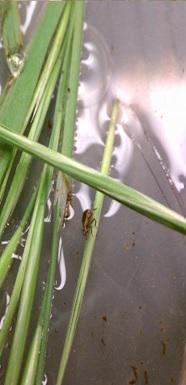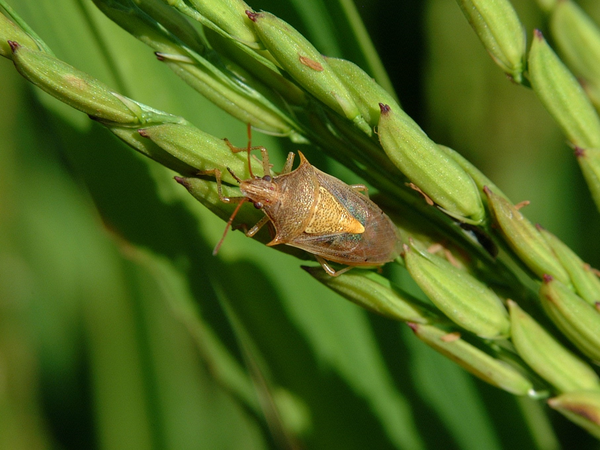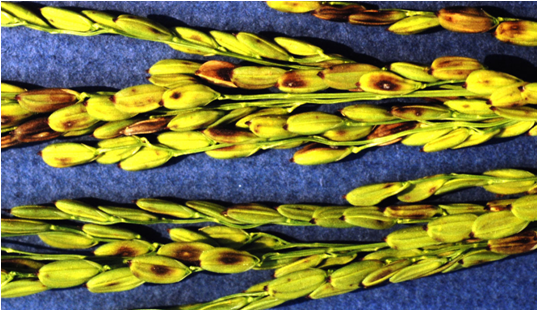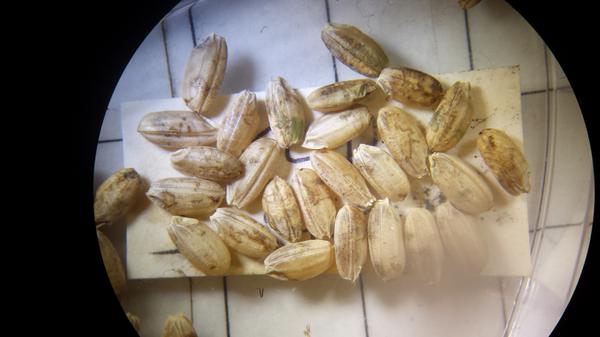General Information
Introduction
Rice is a small acreage crop in North Carolina with no insecticides or herbicides registered for use. A majority of the acreage is grown with the Carolina Gold variety. Due to legal and liability issues we are not allowed to recommend any brand or chemistries of insecticides or herbicides. This leaves growers with no option other than non-chemical means of controlling pests and weeds. Rice is typically produced on small family farms where it is usually a second or third priority crop behind flowers and vegetables. With these limitations in mind we are tailoring these recommendations in a way where you can grow your crop and receive the maximum yield benefits possible given the circumstances. Yields will not be similar to average lowland production along the Mississippi river or the California Central Valley, but you should see some level of increased yields. What follows are a series of cultural and non-chemical controls for weed and pest management.
Field Preparation
Preparing the clay soil fields around the western foothills is vital for a successful rice crop. Fields must be level to avoid uneven flooding which can exacerbate weed and pest problems. If available use a laser leveling platform to achieve this. If not, use string and a leveling tool to plant stakes of the same height into the ground and check field levelness in that manner.
Create small furrows (4 inches wide by 2 inches high) that maximize surface area for the rice plants to grow and allow more air to penetrate the soil prior to flooding and planting. This is only important when seeding the field to give plants more access to oxygen in the early hours after flooding. This is not an issue when transplanting rice during the vegetative stage because you will be walking in the field anyway- furrowing it prior may not be the best use of your time.
Transplanting creates a cleaner stand and allows the rice plant to beat any weeds that may outcompete it. Although transplanting reduces the need for having perfectly leveled fields and water levels, it is still a good idea to make an effort to get the field in the best condition possible.
Pest Management
Each stage is susceptible to a different set of pests and nutrient requirements. Fertilization is important in the first two stages. In water-seed fields draining the water off is necessary to improve maturation rates. Pest pressure can occur at any point once the plant is seeded or transplanted into the field. The greatest pest of concern in North Carolina rice is rice water weevil (Lissorhoptrus oryzophilus) (Figure 1). Stink bugs can be important as well. The rice stink bug (Oebalus pugnax) is a common stink bug in the southern United States that feeds on rice kernels which can reduce quality and yield under heavy infestations (Figure 2). The brown marmorated stink bug (Halyomorpha halys) is also a pest rice in North Carolina (Figure 3).
Rice Water Weevil
Rice water weevil is pest across the United States and there are many non-chemical means available for managing it. Rice water weevil can significantly reduce rice grain yields, averaging 10% -25% yield reduction in large fields. The adults are only 4 mm long with a light brown coloration and sometimes have a dark spot running the length of their backs. Adult feeding does not reduce yields, but larval injury can inflict high yield loss by feeding on the roots in the vegtative phase (Figure 4). At this point the plant is growing and has begun to put out tillers that will later develop panicles and rice grains. The loss of the roots means low yields, unless the plant is able to recover in time before fall harvest.
There are four larval instars that take 28–35 days to develop into pupae in the field and are over 1 cm long when mature (Figure 5). The larvae have special adaptations that pierce plant tissue enabling them to respire in the low oxygen environment of the flooded rice paddy. Larvae build and attach their pupal chambers to the rice root to allow for gas exchange. After a few days the adults emerge and continue the cycle again.
For North Carolina, we recommend the following for managing rice water weevil:
-
Remove all weeds within 10-20 feet of the field prior to flooding. Rice water weevils overwinter in grass clumps near wetland areas and rice fields. Removing them deprives them of food and reduces their populations in the early spring. Burning the field edges is NOT recommended because it has not been shown to work.
-
Decrease flood water levels to less than 5 inches. If you are transplanting you can do this right away. If you are hand seeding, wait until the plant has at least 4-5 fully developed leaves. This discourages the females from laying eggs.
-
Drain fields, if necessary. If you have a severe infestation, drain the field, depending on its size. The smaller the field the less cost this maybe to you. This helps aerate the soil and kill the larvae.
-
Increase plant density. High densities discourage egg laying and limit it to the field edges. The benefits of this are apparent in larger fields. Currently rice is transplanted in clumps of 3-4 plants. We recommend breaking up those clumps and transplanting one plant at a time. Ideally, the recommended stand density is 10-20 plants per square foot. If water seeding, this may translate to 30 seeds per square foot or 10-30 seedlings per square foot. If you wish to continue with transplants then double the density of the transplants.
Stink Bug Management
Adult rice stink bugs have reddish antennae and a body similar to the color of mature rice grains and is about 3⁄8 to 1⁄2 inch in length. The adults overwinter in leaf piles and at the base of grasses. Rice stink bugs prefer feeding grassy hosts before moving into rice. Brown marmorated stink bug can be distinguished easily by white bands on the antennae and legs. Bands on antennae are apparent in both adult and immature forms. Mature adults are approximately 5⁄8 inch (17mm) long and the nymphs range from 1⁄10 to 1⁄2 inch (2.4 to 12mm) long. For more information on BMSB see Brown Marmorated Stink Bug (North Carolina).
Both rice stink bug and BMSB will cause “peck” which is the type of damage seen in Figure 6. It will also cause damage to the kernel itself (Figure 7). However, the only known effective non-chemical method for managing the stink bugs involves eliminating nearby weeds that may serve as hosts and reservoirs. In North Carolina, grasses that should be the targeted for removal include bermudagrass, johnsongrass, annual rye grass, barnyard grass, and crowfoot grass. That should help reduce the incidence of any rice stink bug, if it is common in your area. If you have host trees near the rice fields (tree of heaven, fruit trees, etc.) be sure to check on them for BMSB and deal with them on the fruit trees, otherwise they should not expected to be a problem in your rice field.
Brief Tips on Weed Management (as it relates to pest management)
-
Remove all grass clumps from field edges. Keep the field boundaries clean of weeds.
-
Remove weeds within field. If possible and the manual labor is available, then hand weeding maybe an option. Make sure to remove weeds complete by stripping away the roots
-
Maintain flood levels. Make sure the flood levels are appropriate to discourage dryland weeds. Flooding prevents the growth of barnyard grass which can outcompete rice.
References
Aghaee, M. and L.D. Godfrey. 2014. A Century Rice Water Weevil: A History of Research and Management with an Emphasis on the United States. Journal of Integrated Pest Management 5(4): D1-D14.
Bernhardt, J. 2012. Insect management in rice, pp. 101–112. In Arkansas cooperative extension. Rice production handbook. University of Arkansas, Fayetteville, AK.
Hummel, N., B. Castro, T. E. Reagan, and M. J. Stout. 2012. In Saichuk, J. (ed.), Louisiana rice production handbook. Louisiana State University, Baton Rouge, LA, pp. 93–111.
Publication date: Dec. 9, 2017
Reviewed/Revised: Oct. 1, 2022
N.C. Cooperative Extension prohibits discrimination and harassment regardless of age, color, disability, family and marital status, gender identity, national origin, political beliefs, race, religion, sex (including pregnancy), sexual orientation and veteran status.







